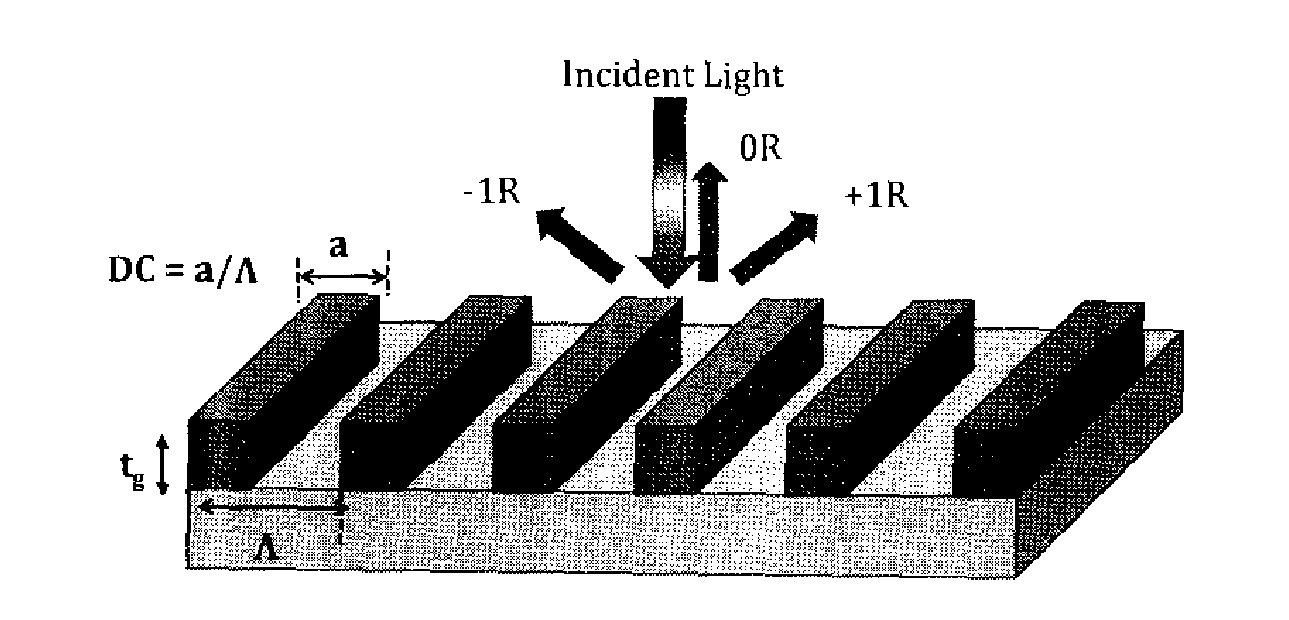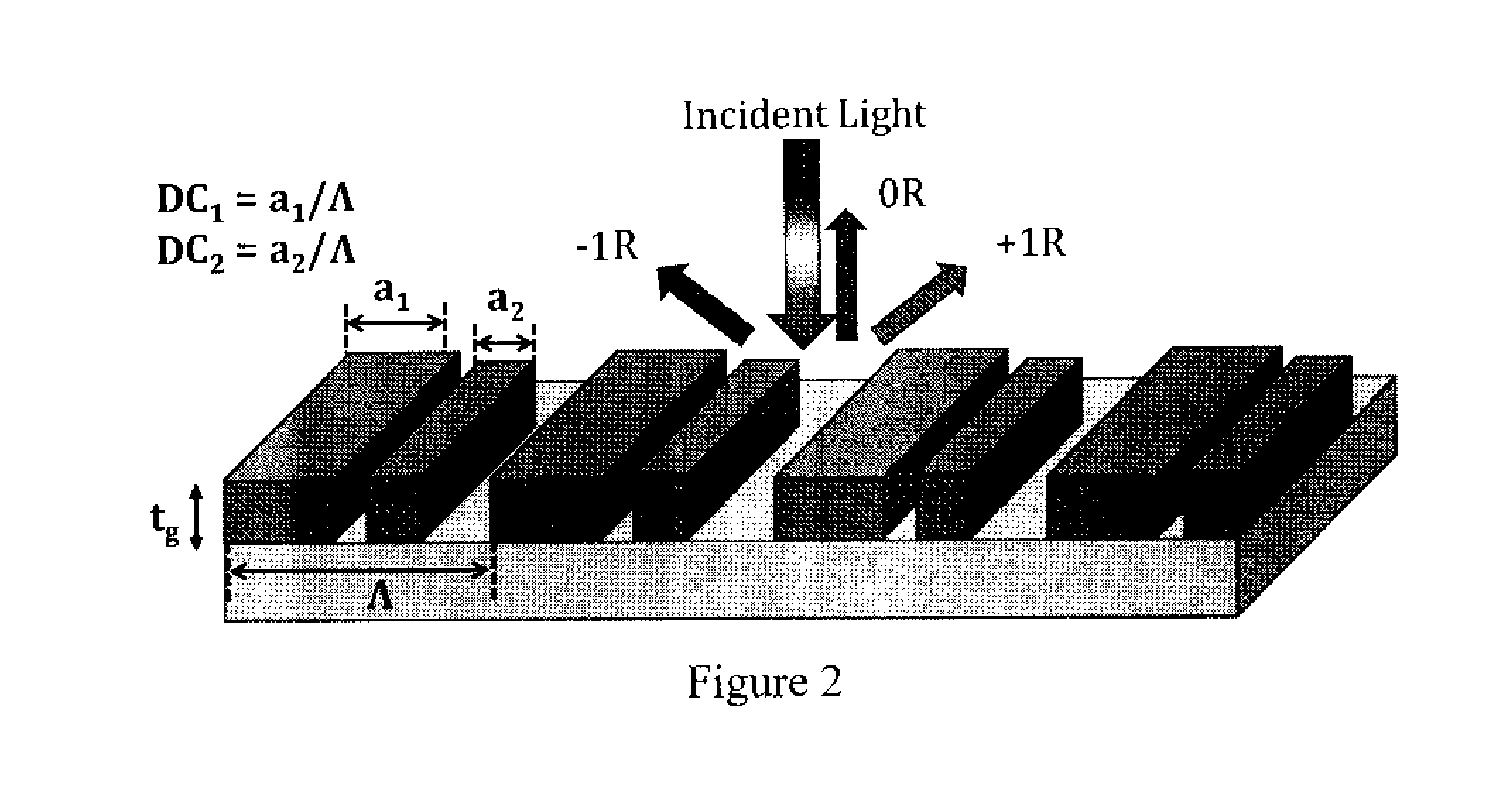Method to design a security feature on the substrate of security documents using sub wavelength grating
a security feature and sub-wavelength technology, applied in the direction of information cards, printing, etc., can solve the problems of high risk of fake or counterfeit currency in such a society, difficult reproduction by counterfeiters, tactile impression, etc., and achieve the effect of convenient extension
- Summary
- Abstract
- Description
- Claims
- Application Information
AI Technical Summary
Benefits of technology
Problems solved by technology
Method used
Image
Examples
example 1
[0080]An example of designing of security thread consists of the sub-wavelength diffraction grating with rectangular shape of thickness tg=0.5 period A=0.5 μm and DC=0.5. The grating material comprising of Silicon derivatives having a refractive index of 3. The asymmetric (which may be symmetric also) subwavelength grating is integrated on top of the SiO, substrate with refractive index 1.5 using interference lithography as shown in FIG. I. This assembly of the substrate and high contrast index grating can be attached to the bank note by interweaving the security thread in the currency note. These optimized parameters enable high reflection efficiency for Oth order reflections of longer wavelengths and high diffraction efficiency of shorter wavelengths giving distinct color differentiation.
example 2
[0081]Symmetric grating design: Simulations were performed based on Rigorous Coupled Wave Analysis (RCWA) to find an optimized design wherein the longer wavelength light (red wavelengths) are reflected at normal incidence and shorter wavelengths (blue / green) are diffracted at glancing angles.
[0082]RCWA is a semi-analytical method in computational electromagnetic that is most typically applied to solve scattering from periodic dielectric structures. It is a Fourier-space method so devices and fields are represented as a sum of spatial harmonics and the scattered field amplitudes are obtained by matching the boundary conditions in electric and magnetic fields at each interface. From this reflection, transmission and diffraction efficiencies are calculated.
[0083]FIG. 3 shows the contour plot of intensity of light reflected for a duty cycle DC of 0.5 and for various thickness values “tg” of the grating for 0th order reflection. Refractive index of the grating is assumed to be 2.5 and th...
example 3
[0087]Asymmetric grating design: Simulations are performed based on RCWA to find an optimized design wherein the longer wavelength light (red wavelengths) are reflected at normal incidence and shorter wavelengths (blue / green) are diffracted at glancing angles.
[0088]This example shows the advantage of using asymmetric gratings to obtain additional visual effect so that the color perceived at glancing angles is different when viewed from the left or the right. The optimized grating structure has parameters tg / A=0.3 and duty cycles DC1 of 0.56 and DC2 of 0.1 (FIG. 2). The polarization is assumed to be TM. FIG. 7 shows the spectrum of light which will be perceived by the eye after reflection from the asymmetric grating structure at normal viewing angle. FIGS. 8 and 9 show the reflected spectrum of light at glancing angles. The spectrum clearly shows that for minus and plus first order diffracted light, the spectrum perceived by eyes would be different. With further design optimization, ...
PUM
| Property | Measurement | Unit |
|---|---|---|
| Length | aaaaa | aaaaa |
| Length | aaaaa | aaaaa |
| Length | aaaaa | aaaaa |
Abstract
Description
Claims
Application Information
 Login to View More
Login to View More - R&D
- Intellectual Property
- Life Sciences
- Materials
- Tech Scout
- Unparalleled Data Quality
- Higher Quality Content
- 60% Fewer Hallucinations
Browse by: Latest US Patents, China's latest patents, Technical Efficacy Thesaurus, Application Domain, Technology Topic, Popular Technical Reports.
© 2025 PatSnap. All rights reserved.Legal|Privacy policy|Modern Slavery Act Transparency Statement|Sitemap|About US| Contact US: help@patsnap.com



